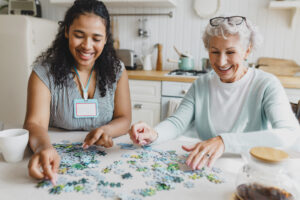Suppose that someone asked you, “Where do you want to go home to tonight?” After they rule out an all-inclusive tropical island as an option, your response would likely be, “What do you mean, ‘Where do I want to go home to?’ I want to go home to my house.” It seems like a frivolous question. But it’s a serious question for a lot of aging adults, and most of them are likely to answer in the same way that you would.
We put love and energy and other kinds of investments into our homes, and they hold space for our lives as we choose to live them. But with aging come barriers and challenges to living in our homes independently as we have been used to doing for decades. Older adults may face limited mobility and dexterity, difficulty with memory and cognition, and higher risk of social isolation. As a result, they may face even bigger life changes if they’re forced to move into another living situation that provides regular assistance.
People are living longer these days, which introduces fresh challenges to everyday life for older adults. But technology is also going further, and tech innovations can help us to overcome some of these new challenges. When safety is an issue, technological devices can give everyone involved a greater sense of security when an aging adult is living alone—or these devices can act in conjunction with at-home caregiving to afford the individual greater independence when possible. When safety is not an issue, aging-in-place technology helps everyone to relax and go about their lives, knowing that should anything go wrong, they won’t miss a beat in getting urgent attention to an aging loved one. Let’s not take for granted the benefits of living comfortably at home; let’s instead look proactively for the solutions and the technology to help seniors live independently where they want to.
Exploring Technology That Helps Seniors to Live Independently
The best technology solutions for seniors are those that integrate seamlessly into their lives, supporting their habits and routines rather than changing them altogether. Let’s look at some of the latest developments in technology that allow seniors greater independence.
- Tablets and Smartphones. The advent of touchscreens and intuitive interfaces on handheld devices has meant greater ease and accessibility for older adults using technology. Applications can keep track of schedules and deliver reminders, provide entertainment and games, take and store photos and videos, and even track medication and medical history—and this is just a handful of the possibilities. The challenges of living alone aren’t just logistical; tablets and smartphones can help to create social connections as well through video calls with family and friends and social networks where older adults can find belonging and purpose. The built-in assistive technology designed for seniors can help them to overcome limitations due to vision and hearing loss and dexterity challenges. Natural language processing (NLP) is another innovative tool that harnesses speech to control digital applications. Someone can listen for prompts and speak commands rather than needing to type or push buttons, and it makes the interaction with technology a bit more friendly (think: Siri or Alexa).
- Tracking Devices for Active Lifestyles. Fitness tracking devices, such as Fitbits, may not be marketed toward the older generations, but they can be perfect tools for anyone interested in following an active lifestyle. These are typically wearable devices that can measure heart rate, track steps taken, count calories burned, and even monitor sleep quality. That data is converted into charts that your aging loved one can view on their tablet or smartphone. They can use this system to set and track goals for healthy living.
- In-home Monitoring Systems. It is now possible for sensors placed around the house to monitor an older adult’s movement and daily habits without the use of cameras that can infringe on their privacy. Sensors placed under bed sheets can analyze how well someone is sleeping, on the fridge door can track when someone is opening it, under the carpet can track movement and even changes in gait. Sensors are becoming ever more precise and some can now can distinguish between the sound of a person falling and some other big noise that wouldn’t warrant the same kind of urgent attention. This kind of technology can be an important resource for long-distance caregivers to rest assured when their loved one’s habits are normal or to be alerted when they haven’t gotten out of bed, haven’t opened the fridge or medicine cabinet for too long, or when other unusual patterns are reported.
- Health Monitors. Wearable devices—often stuck directly to the skin—can track an older adult’s vitals, including blood pressure, temperature, oxygen, sleep patterns, cardiac health, blood glucose, and even hydration. Beyond the functionality of fitness trackers, these monitors, such as the BodyGuardian®, can send data directly to healthcare providers to support more informed patient care. The range of monitoring is extensive, but with this working in the background, caregivers need to worry only when there’s a problem. We can focus on all of the life in between and around the health concerns and encourage our aging loved ones to do the same. And these tools are so easy to use because they are constantly tracking when the device is on the individual, and you can pull up the records in an application on your device.
- Emergency Response Systems. Personal Emergency Response Systems (PERS) have been around for awhile, but they have become more accurate and more discreet with technological advancements. When an aging adult wears a PERS device, either they push a button in a case of emergency and/or the device is able to automatically detect a fall and alert emergency services and the programmed numbers of family and caregivers. Mobile versions don’t need to be in the person’s house to work because they are enabled with GPS; the person can be out running errands or doing other independent tasks, and when activated the emergency services will be able to find the older adult right where they are. Some even allow for two-way communication, so it doesn’t just alert the concerned individuals; it also allows the wearer to communicate with someone in real time through the device.
- Medication Dispensers and Reminders. When an aging adult has trouble with memory, it can be dangerous for them to forget a medication dose and also for them to forget whether they already took their medicine and end up doubling their doses. This can be a compelling reason for having an at-home caregiver, but there is also technology that can help for elderly living alone. In some cases, all an aging adult needs is a reminder, so phones and tablets can be set to ring and vibrate when it is time to take medications. In other cases, people need additional assistance taking the proper doses and medications—especially when there are multiple times a day when they need to take them. Medication dispensing systems not only alert them when it is time to take their pills, but also dispense the proper dosages that have been fed into the machine by a caregiver already.
How Can You Help an Older Adult to Embrace Aging in Place Technology?
Technology can be confusing and intimidating for older adults who haven’t grown up with it as younger generations have. But the benefits of technology for seniors are far-reaching, and these innovative solutions can empower and enable people to continue living their best lives for longer. When you get involved with these devices and applications with your aging loved one, the chances are better that they will open up to learning and to the possibilities for benefit. It may help for them to just watch you navigate a system first. And it always helps to break up the productive tasks with fun ones, such as chatting with a grandchild from afar or flipping through a photo album.
Just as so many of us have gotten used to technology helping normal life run more smoothly, aging adults can integrate technology solutions and live safely in their homes for longer. As a caregiver, you can keep an eye out for technology resources that may be particularly helpful for your aging loved one, and you can help them to get familiar and begin using these resources as naturally as you do. The greatest gift will be for them to continue going home to the place they call home.
At Institute on Aging, our diverse programs, services, and resources support the cause of aging in place because we see clearly the possibilities and benefits of seniors continuing to live at home in their communities. Reach out to us today to learn more.







